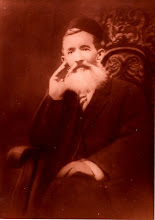Today, I read an interesting post in the neurocritic's blog about a type of brain cell called a spindle cell or Von Economo cell. The blog entry stated that one of the areas these cells are located in is in the frontal area of the brain. Recent research has indicated an excessive number of neurons in the dorsofrontal cortex of some postmortem autistic brains. Also, apparently, there is destruction of these cells in frontotemporal dementia. In a recent post, I wrote about parallels between FTD and autism.
Naturally these made me wonder if these cells might somehow be involved in autism. I asked the neurocritic and he replied: jonathan - There have been speculations that VENs might be involved in
autism, but conflicting studies have found greater, fewer, or the same
number of VENs. Kind of hard to interpret that. Allman et al. said:
"There
are many features of autism that suggest that the VENs may be involved
in this disorder. An initial stereological study of the number of VENs
in area FI in four autistic subjects plus controls did not confirm this
conjecture. However, a second stereological study of VENs in dorsal ACC
in nine autistic subjects plus controls found that the autistic subjects
fell into two groups, one with significantly higher numbers of VENs
than controls, and the other with significantly fewer VENs than
controls. Thus the controls occupied a middle zone with little overlap
with the high or low VEN autism groups."
When in doubt, postulate distinct subgroups.
Until recently, it was believed that these cells only existed only in humans along with a few other highly evolved primates. Neurocritic's post dealt with a recent finding of these cells in a lower primate, macaque monkeys. It has been subsequently discovered that these cells are also found in elephants and some whales, apparently only in larger mammals including at least some primates. These neurons develop late. They are small in number at the 35th week of gestation. At birth, a person only has 15% of their final total number of VENs. They continue to grow in the brain up until about age four, coincidentally during the time of the first onset of autism or the time during which at least a partial recovery from autism can be made (as was the case of myself around the age of four, when I regained my speech).
The fact that various findings from studies of these cells in autism is mixed, does not preclude the possibility that a problem with these cells, e.g. too few, too many or problems with formation and migration could be involved in at least some cases though not necessarily all. in an article by the courchesne group , mention is made of two different studies in which 53% and 58% more voneconomo neurons were found in autistic brains versus controls respectively.
John Allman of Cal Tech speculated that VEN's found in the frontoinsular cortex and the anterior cingulate relayed outputs to portions of the frontal and temporal cortex where theory of mind and other social decisions are made and propose the possibility that impairments in this area may be responsible for social deficits found in autism.
He reports an MRI study in which the area containing VENs in the anterior cingulate gyrus is reduced in volume compared to matched controls. tensor diffusion studies also showed white matter abnormalities in some autistic subjects. This also might be consistent with recent work of Courchesne showing excessive growth in the dorsofrontal cortex as well as the recent genetic study using this data. However, Courchesne stated in the above-linked paper that VEN's accounted for too low a percentage of all neurons in the frontal lobe to be totally responsible for all of the brain growth.
So, in my desire to finally uncover the etiology of my problems and the reason for my immense suffering, Von Economo neurons may be yet another leaf to be unturned.
Subscribe to:
Post Comments (Atom)


No comments:
Post a Comment